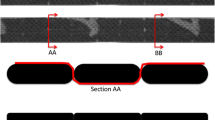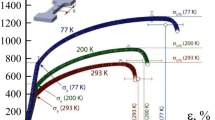Abstract
The effect of strain rate on the compressive behavior of thick carbon/epoxy composite materials was investigated. Falling weight impact and split Hopkinson pressure bar systems were developed for dynamic characterization of composite materials in compression at strain rates up to 2000 s−1. Strain rates below 10 s−1 were generated using a servohydraulic testing machine. Strain rates between 10 s−1 and 500 s−1 were generated using the drop tower apparatus. Strain rates above 500 s−1 were generated using the split Hopkinson pressure bar. Unidirectional carbon/epoxy laminates (IM6G/3501-6) loaded in the longitudinal and transverse directions, and\([(0_8 /90_8 )_2 /\bar 0_8 ]_s \) cross-ply laminates were characterized. The 90-deg properties, which are governed by the matrix, show an increase in modulus and strength over the static values but no significant change in ultimate strain. The 0-deg and cross-ply laminates show higher strength and ultimte strain values as the strain rate increases, whereas the modulus increnases only slightly over the static value. The increase in strength and ultimate strain observed may be related to the shear behavior of the composite and the change in failure modes. In all cases, the dynamic stress-strain curves stiffen as the strain rate increases. The stiffening is lowest in the longitudinal direction and highest in the transverse direction.
Similar content being viewed by others
References
Rotem, A. Lifshitz, J.M., “Ongitidinal Strength of Unidirectional Fibrous Composite Under High Rate of Loading,” Proc. 26th Annual Tech. Conf. Soc. Plastics Industry, Reinforced Plastics/Composites Division, Washington, DC, Section 10-G, 1–10 (1971).
Lifshitz, J.M., “Impact Strength of Angle Ply Fibe Reinforced Materials,”J. Composite Mat.,10 (1),92–101 (1976).
Sierakowski, R.L., Nevil, G.E., Ross, A., andJones, E.R., “Dynamic Compressive Strength and Failure of Steel Reinforced Epoxy Composites,”J. Composite Mat.,5 (3),362–377 (1971).
El-Habak, A.M.A., “Mechanical Behavior Wovene Glass Fibrereinforced Composites Under Impact Compression Load,”Composites 22 (2),129–134 (1991).
Harding, J., “Effect of Strain Rate and Specimen Geometry on the Compressive Strength of Woven Glass-reinforced Epoxy Laminates,”Compositesi,24 (4),323–332 (1993).
Lifshitz, J. M. andLeber, H., “Data Processing in the Split Hopkinson Bar Tests,”I(nt. J. Impact Eng.,15 (6),723–733 (1994).
Powers, B.M., Vinson, J.R., Wardle, M., and Scott, B., “High Strain Rate Effects on AS4/PEEK Graphite Fiber Thermoplastic Matrix Composites,” Proc. American Society for Composites, ed. W.S. Johnson, 486–494 (1996).
Weeks, C.A. and Sun, C.T., “Nonlinear Rate Dependent Response of Thick-section Composite Laminates,” High Strain Rate Effects on Polymer, Metal and Ceramic Matix Composites and Other Advanced Materials, ASME AD-48 ed. Y.D.S. Rajapakse and J.R. Vinson, 81–95 (1995).
Amijima, S. and Fujii, T., “compressive Strength and Fracture Characteristics of Fiber Composites Under Impact Loading,” Proc. 3rd Int. Conf. composite Materials, ICCM III, ed. A.R. Russell, Paris, 399–413 (1980).
Daniel, I.M. andLaBedz, R.H., “Method for Compressio Testing of Composite Materials at High Strain Rates,”Compression Testing of Homogeneous Materials and Composites, ASTM STP 808, ed. R. Chait andR. Rapirno, American Society for Testing and Materials, Philadelphia, PA, 121–139 (1983).
Montiel, D.M. andWilliams, C.J., “A Method for Evaluating the High Strain Rate Compressive Properties of Composite Materials,”Composite Materials: Testing and Design, ASTM StP 1120, ed. G.C. Grimes, American Society for Testing and Materials, Philadelphia, PA 10,54–65 (1992).
Groves, S.E., Sanchez, R.J., Lyon, R.E., andBrown, A.E., “High Strain Rate Effects for Composite Materials,”Composite Materials: Testing and Design, ASTM STP 1206, ed E.T. Camponeschi, American Society for Testing and Materials, Philadelphia, PA,11,162–176 (1993).
Gresczuk, L.B., “Damage in Composite Materials Due to Low Velocity Impact,”Impact Dynamics John Wiley & Sons, New York, Chap. 3 (1982).
Sierakowski, R.L., “High Strain Rate Testing of Composites,” Proc. Dyanmic Constitutive Failure Models, AFWAL-TR-88-4229, ed. A.M. Rajendran and T. Nicholas (December 1988).
Sierakowski, R.L., “Strain Rate Behavior Composites: Issues,” High Strain Rate Effects on Polymer, Metals and Ceramic Matric Composites and Other Advanced Materials, ASME AD-48,ed. Y.D.S. Rajapakse and J.R. Vinson, 1–5 (1995).
Daniel, I.M., Hsiao, H.M., Wooh, S.C., and Vittoser, J., “Processing and Compressive Behavior of Thick Composites,” Mechanics of Thick Composites, ASME AMD-162,ed. Y.D.S. Rajapakse, 107–126 (1993).
Hsiao, H.M., Daniel, I.M., and Cordes, R.D., “Strain Rate Effects on the Transverse Compressive and Shear Behavior of Unidirectional Composites,” J. Composite Mat. (1996).
Tzeng, J.T. and Abrahamian, A.S., “Dynamic Compressive Properties of Laminated Composites at High Rates of Loading,” Proc. American Society for Composites, ed. W.S. Johnson, 178–188 (1996).
Winkel, J.D. andAdams, D.F., “Instrumented Drop Weight Impact Testing of Crossply and Fabric Composites,”Composites,16 (4),268–278 (1985).
Kolsky, H., “An Investigation of the Mechanical Properties of Materials at Very High Rates of Loading,”Proc. Phys. Soc. Lond., Series B,62,676–700 (1949).
Follansbee, P.S., “The Hopkinson Bar,”Metals Handbook,8,9th ed. 198–203 (1985).
Follansbee, P.S. andFrantz, C., “Wave Propagation in the Split Hopkinson Pressure Bar,”Trans. ASME, J. Eng. Mat. Tech.,105 (1),61–66 (1983).
Litaillade, J.-L., Bacon, C., Collombet F., andDelaet, M., “The Benefit of Hopkinson Bar Techniques for the Investigation of Composite and Ceramic Materials,” Wave Propagation and Emerging Technologies, ASME AMD-188,85–94 (1994).
Raghavan, J. andMeshii, M., “Time-dependent damage in Carbon Febre-reinforced Polymer Composites,”Composites Part A,27A (12),1223–1227 (1996).
Christensen R.M., Theory of Viscoelasticity, Academic Press, New York (1971).
Williams, J.G., Fracture Mechanics of Polymers, Ellis Horwood, London (1984).
Häberle, J.G. andMatthews, F.L., “An Improved Technique for Compression Testing of Unidirectional Fibre-reinforced Plastics: Development and Results,”Compositesi,25,358–371 (1994).
Camponeschi, E.T., Jr., “Compression Testing of Thick-section Composite Materials,”Composite Materials: Fatigue and Fracture, ASTM STP 1110, America Society for Testing and Materials, Philadelphia, PA, 439–456 (1991).
Hsiao, H.M., Daniel, I.M., Wooh, S.C., “A New Compression Test Method for Thick Composites,”J. Composite Mat.,29 (13),1789–1806 (1995).
Budiansky, B., “Micromechanics,”Computer Struct.,16,3–12 (1983).
Häberle, J.G. andMatthews, F.L., “A Micromechanics Model for Compressive Failure of Unidirrectional Fibre-reinforced Plasticis,”J. Composite Mat.,28 (17),1618–1639 (1994).
Daniel, I.M., Hsiao, H.M., andWooh, S.C., “Failure Mechanisms in Thick composites Under Compressive Loading,”Composites Part B.,27B (6),543–552 (1996).
Barre, S., Chotard, T., andBenzeggagh, M.L., “Comparative Study of Strain Rate Effects on Mechanical Properties of Glass Fibre-reinforced Thermoset Matrix Composites,”Composites Part A,27A (12),1169–1181 (1996).
Author information
Authors and Affiliations
Rights and permissions
About this article
Cite this article
Hsiao, H.M., Daniel, I.M. & Cordes, R.D. Dynamic compressive behavior of thick composite materials. Experimental Mechanics 38, 172–180 (1998). https://doi.org/10.1007/BF02325740
Received:
Issue Date:
DOI: https://doi.org/10.1007/BF02325740




